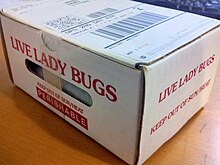Beneficial insects (sometimes called beneficial bugs) are any of a number of species of insects that perform valued services like pollination and pest control. The concept of beneficial is subjective and only arises in light of desired outcomes from a human perspective. In agriculture, where the goal is to raise selected crops, insects that hinder the production process are classified as pests, while insects that assist production are considered beneficial. In horticulture and gardening, beneficial insects are often considered those that contribute to pest control and native habitat integration.

Encouraging beneficial insects, by providing suitable living conditions, is a pest control strategy, often used in organic farming, organic gardening or integrated pest management. Companies specializing in biological pest control sell many types of beneficial insects, particularly for use in enclosed areas, like greenhouses.
Types
editSome species of bee are beneficial as pollinators, although generally only efficient at pollinating plants from the same area of origin, facilitating propagation and fruit production for many plants. This group includes not only honeybees, but also many other kinds of bees that are more efficient at pollinating plants native to their region. Bees can be attracted by many companion plants, especially bee balm and pineapple sage for honeybees. Wasps, especially fig wasps are also beneficial as pollinators.[1]
Ladybugs are generally thought of as beneficial because they eat large quantities of aphids, mites and other arthropods that feed on various plants.
Other insects commonly identified as beneficial include:[2][3][4]
Attractive plants
editPlants in the families Apiaceae and Asteraceae are generally valuable companions. Here are other plants that attract beneficial insects:
See also
edit- Beneficial organism
- Beneficial weeds
- International Organization for Biological Control
- List of companion plants – a common companion plant's function is the attraction of beneficial insects.
- List of beneficial weeds
- Organic gardening
- Satoyama
- Sustainable gardening
- Wildlife garden
References
edit- ^ "Wasp Pollination". U. S. Forest Service. United States Department of Agriculture. Retrieved 5 January 2021.
- ^ "Farmscaping to Enhance Biological Control" Archived 2010-04-26 at the Wayback Machine, ATTRA - National Sustainable Agriculture Information Service.
- ^ Xerces Society (2014). Burns, Deborah (ed.). Farming with Native Beneficial Insects: Ecological Pest Control Solutions. North Adams, Massachusetts: Storey Publishing. pp. 183–207. ISBN 9781612122830.
- ^ Miller, Carley (2021-07-22). "16 Beneficial Garden Insects to Consider". The Green Pinky. Retrieved 2021-12-07.
Additional sources
edit- "Phillip Alampi Beneficial Insect Rearing Laboratory". State of New Jersey Department of Agriculture. Retrieved August 2, 2012.
- "Beneficial insect habitat in an apple orchard: Effects on pests". Research Brief #71. Center for Integrated Agricultural Systems, College of Agricultural and Life Sciences, University of Wisconsin-Madison. September 2004. Retrieved August 2, 2012.
- "Orchardists Install Beneficial Insect and Pollinator Habit". USDA Natural Resources Conservation Service. Archived from the original on February 21, 2013. Retrieved August 2, 2012.
External links
edit- Association of Natural Biocontrol Producers – trade association of the biological control industry
- Beneficial Insects for Hydroponics